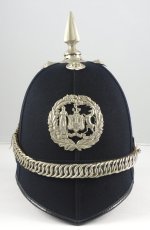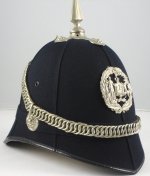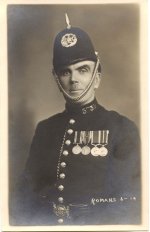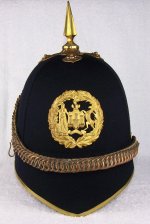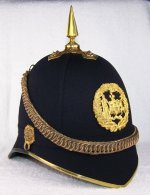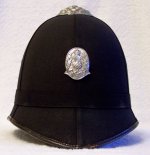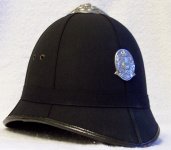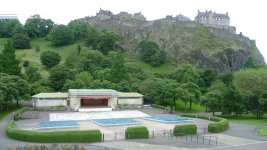RoyalScotsVols
Member
Edinburgh is the capital city of Scotland and has a long history. After the Union of the Crowns in 1603 James VI of Scotland ascended to the throne of England which greatly renewed the fortunes of the City of Edinburgh bringing increased trade but also the associated crime and occasional political disorder. Thus the High Constables of Edinburgh were founded by an act of Parliament which ‘command[ed] the magistrates of Edinburgh to appoint some persons to guard their streets’. Accordingly, a number of constables were appointed – half were merchants and half were craftsmen - and they were charged with enforcing 16 regulations, relating to curfews, weapons and thefts. It is believed that the High Constables of Edinburgh are the first example of a statutory police force in the world.
As the city grew, the High Constables were augmented in 1679 by a uniformed Town Guard dressed and armed in the style of a Militia. This stalwart body of men had the unenviable tasks of patrolling the towns darker quarters, forming the guard at public executions and other events along with attempting to maintain civil order to a level that was acceptable to the city fathers. The ’Toun Rats’ or ‘Toon Rottens’ as they became known by the villainous population built up a fearsome reputation for toughness and brutality which in view of some of the reports of the behaviour of the populace may seem quite excusable. The majority of the recruits to the Town Guard came from the Highland Regiments and posts were highly contested as such service was considered an easy way to make a handsome six shillings a day, particularly after the rigours of military service. The uniform was described by Sir Walter Scott (famous novelist, poet and historian) and remained basically unchanged throughout their existence. The long-tailed coats were brick red with dark blue collars and facings and a buff yellow lining visible on the turned back tails. Waistcoats and breeches were also brick red with dark blue knee-length gaiters and black boots. Cross belts were white pipe clayed and a large black cocked hat piped with white worsted ribbon remained their distinctive headgear. Their arsenal of weaponry included flintlock muskets, lochaber-axes (a peculiarly Scottish weapon with a hook one side and a blade the other), halberds and partisans (an ornate form of ceremonial halberd).
The Town Guard had a long and rather, shall we say, 'chequered' history. They were no doubt despised during their existence but those who despised them were mainly of the unruly element. They were certainly a memorable and picturesque part of old Edinburgh folklore. However, by the early 1800’s it had become clear that a more professional force was required. The Edinburgh Police Act of 1805 established the Edinburgh City Police to replace both the previous Town Guard and the High Constables (although this organisation lives on to this day as a purely ceremonial force).
Pictured below is the style of helmet worn by ECP from circa 1880 to 1932 - it has a smooth blue cloth covering over the cork body, a cloth covered top mount and cloth central band. The helmet plate is the Edinburgh Coat of Arms featuring a castle, an anchor, a maiden, a doe and the moto 'Nisi Dominus Frustra'. The castle symbolizes Edinburgh Castle, the anchor represents the Lord Provost's role as Admiral of the Firth of Forth and the maiden and doe are derived from the castle's historical nickname 'Castle of the Maidens' and the city's patron saint, St Giles, respectively. The moto translates to 'Without the Lord, all is in vain'.
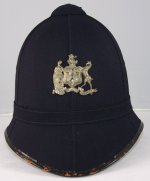
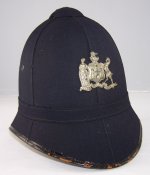
The picture below is also from my collection with the very fresh-faced young constable having been able to be identified from researching his collar number. He is believed to be Thomas (Tom) Bell who joined Edinburgh City Police on 1 September 1914 as PC577D until 1 June 1915 when he resigned to join the Army. He served with the 13th Battalion of the Royal Scots until he was killed in action on 27 February 1916 at 22 years old. He was the son of George Dickson Bell of Stenton, Prestonkirk and the late Elizabeth Veitch Bell. He is commemorated on the War Memorial in the West End Police Station in Torphichen Place, Edinburgh.
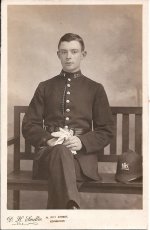
As the city grew, the High Constables were augmented in 1679 by a uniformed Town Guard dressed and armed in the style of a Militia. This stalwart body of men had the unenviable tasks of patrolling the towns darker quarters, forming the guard at public executions and other events along with attempting to maintain civil order to a level that was acceptable to the city fathers. The ’Toun Rats’ or ‘Toon Rottens’ as they became known by the villainous population built up a fearsome reputation for toughness and brutality which in view of some of the reports of the behaviour of the populace may seem quite excusable. The majority of the recruits to the Town Guard came from the Highland Regiments and posts were highly contested as such service was considered an easy way to make a handsome six shillings a day, particularly after the rigours of military service. The uniform was described by Sir Walter Scott (famous novelist, poet and historian) and remained basically unchanged throughout their existence. The long-tailed coats were brick red with dark blue collars and facings and a buff yellow lining visible on the turned back tails. Waistcoats and breeches were also brick red with dark blue knee-length gaiters and black boots. Cross belts were white pipe clayed and a large black cocked hat piped with white worsted ribbon remained their distinctive headgear. Their arsenal of weaponry included flintlock muskets, lochaber-axes (a peculiarly Scottish weapon with a hook one side and a blade the other), halberds and partisans (an ornate form of ceremonial halberd).
The Town Guard had a long and rather, shall we say, 'chequered' history. They were no doubt despised during their existence but those who despised them were mainly of the unruly element. They were certainly a memorable and picturesque part of old Edinburgh folklore. However, by the early 1800’s it had become clear that a more professional force was required. The Edinburgh Police Act of 1805 established the Edinburgh City Police to replace both the previous Town Guard and the High Constables (although this organisation lives on to this day as a purely ceremonial force).
Pictured below is the style of helmet worn by ECP from circa 1880 to 1932 - it has a smooth blue cloth covering over the cork body, a cloth covered top mount and cloth central band. The helmet plate is the Edinburgh Coat of Arms featuring a castle, an anchor, a maiden, a doe and the moto 'Nisi Dominus Frustra'. The castle symbolizes Edinburgh Castle, the anchor represents the Lord Provost's role as Admiral of the Firth of Forth and the maiden and doe are derived from the castle's historical nickname 'Castle of the Maidens' and the city's patron saint, St Giles, respectively. The moto translates to 'Without the Lord, all is in vain'.


The picture below is also from my collection with the very fresh-faced young constable having been able to be identified from researching his collar number. He is believed to be Thomas (Tom) Bell who joined Edinburgh City Police on 1 September 1914 as PC577D until 1 June 1915 when he resigned to join the Army. He served with the 13th Battalion of the Royal Scots until he was killed in action on 27 February 1916 at 22 years old. He was the son of George Dickson Bell of Stenton, Prestonkirk and the late Elizabeth Veitch Bell. He is commemorated on the War Memorial in the West End Police Station in Torphichen Place, Edinburgh.

Last edited:

